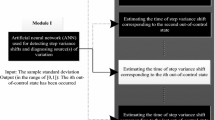Abstract
Control charts are useful tools of monitoring quality characteristics. One of the problems of employing a control chart is that the time it alarms is not synchronic with the time when assignable cause manifests itself in the process. This makes difficult to search and find assignable causes. Knowing the real time of manifestation of assignable cause (change point) helps to find assignable cause(s) sooner and eases corrective actions to be taken. In this paper, a probabilistic neural network (PNN)-based procedure was developed to estimate the variance change point of a normally distributed quality characteristic. The PNN was selected based on trial and error among different types of artificial neural networks and on the basis of its advantages such as fast training process, converging to optimal classifier and adding or removing samples without extensive retraining. In the proposed procedure, the signal is first received by an \(S^{2}\) control chart and then based on the designed tests of hypothesis, which distinguish the size of shift in the variance, a suitable PNN is activated. The performance of the proposed procedure is evaluated through extensive simulation studies. In addition, the results of a comparison study with the maximum likelihood estimation (MLE) method show that the proposed procedure outperforms MLE in estimating the real time of the step change in variance of a normal quality characteristic. Finally, an illustrative example is presented to clarify the procedure step by step.




Similar content being viewed by others
References
Ahmadzadeh F (2011) Change point detection with multivariate control charts by artificial neural network. J Adv Manuf Technol (published online). doi:10.1007/s00170-009-2193-6
Amiri A, Allahyari S (2012) Change point estimation methods for control chart post signal diagnostics: a literature review. Qual Reliab Eng Int 28:637–685
Amiri A, Khosravi R (2013) Identifying time of a monotonic change in the fraction nonconforming of a high quality process. J Adv Manuf Technol 68:547–555
Amiri A, Khosravi R (2012) Estimating the change point of cumulative count of conforming control chart under a drift. Scientia Iranica 19:856–861
Atashgar K, Noorossana R (2011) An integrating approach to root cause analysis of a bivariate mean vector with a linear trend disturbance. Int J Adv Manuf Technol 52:407–420
Hawkins DM, Qiu P, Kang CW (2003) The change point model for statistical process control. J Qual Technol 35:355–366
John A (2000) Multiple change point detection with genetic algorithm. Soft Comput 4:68–75
Lee J, Park C (2007) Estimation of the change point in monitoring the process mean and variance. Commun Stat Simul C 36:1333–1345
Li F, Runger GC, Tuv E (2006) Supervised learning for change point detection. Int J Prod Res 44:2853–2868
Niaki STA, Khedmati M (2012) Detecting and estimating the time of a step-change in multivariate poisson processes. Scientia Iranica 19:862–871
Noorossana R, Shadman A (2009) Estimating the change point of a normal process mean with a monotonic change. Qual Reliab Eng Int 25:79–90
Oh KJ, Moon MS, Kim TY (2005) Variance change point detection via artificial neural networks for data separation. Neurocomputing 68:239–250
Park J, Park S (2004) Estimation of the change point in the \(x\) and s control charts. Commun Stat Simul C 33:1115–1132
Perry MB, Pignatiello JJ, Simpson JR (2006) Estimating the change point of a poisson rate parameter with a linear trend disturbance. Qual Reliab Eng Int 22:371–384
Perry MB, Pignatiello JJ, Simpson JR (2007) Change point estimation for monotonically changing poisson rates in SPC. Int J Prod Res 45:1791–1813
Perry MB, Pignatiello JJ (2008) A change point model for the location parameter of exponential family densities. IIE Trans 40:947–956
Perry MB (2010) Identifying the time of polynomial drifts in the mean of auto correlated processes. Qual Reliab Eng Int 26:399–415
Pignatiello JJ, Samuel TR (2001) Estimation of the change point of a normal process mean in SPC applications. J Qual Technol 33:82–95
Samuel TR, Pignatiello JJ, Calvin JA (1998) Identifying the time of a step change with \(x\) control charts. Qual Eng 10:521–527
Zandi F, Niaki STA, Nayeri MA, Fathi M (2011) Change-point estimation of the process fraction non-conforming with a linear trend in statistical process control. Int J Comp Integr M 24:939–947
Zhao w, Tian Z, Xia Z (2010) Ratio test for variance change point in linear process with long memory. Stat Paper 51:397–407
Acknowledgments
The authors are thankful to anonymous reviewers for their precious comments which led to significant improvement in the paper.
Author information
Authors and Affiliations
Corresponding author
Additional information
Communicated by V. Loia.
Rights and permissions
About this article
Cite this article
Amiri, A., Niaki, S.T.A. & Moghadam, A.T. A probabilistic artificial neural network-based procedure for variance change point estimation. Soft Comput 19, 691–700 (2015). https://doi.org/10.1007/s00500-014-1293-x
Published:
Issue Date:
DOI: https://doi.org/10.1007/s00500-014-1293-x




